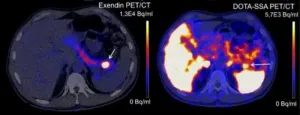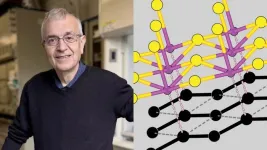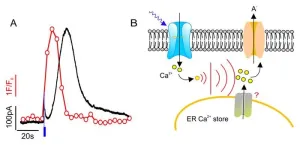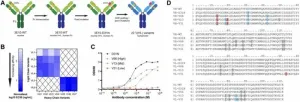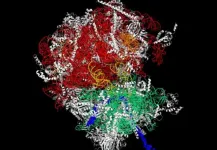Microbes drove methane growth between 2020 and 2022, not fossil fuels, study shows
2024-10-21
Microbes in the environment, not fossil fuels, have been driving the recent surge in methane emissions globally, according to a new, detailed analysis published Oct 28 in the Proceedings of the National Academy of Sciences by CU Boulder researchers and collaborators.
“Understanding where the methane is coming from helps us guide effective mitigation strategies,” said Sylvia Michel, a senior research assistant at the Institute of Arctic and Alpine Research(INSTAAR) and a doctoral student in the Department of Atmospheric and Oceanic Sciences at CU Boulder. “We need to know more about those emissions to ...
Re-engineered, blue light-activated immune cells penetrate and kill solid tumors
2024-10-21
HERSHEY, Pa. — Immunotherapies that mobilize a patient’s own immune system to fight cancer have become a treatment pillar. These therapies, including CAR T-cell therapy, have performed well in cancers like leukemias and lymphomas, but the results have been less promising in solid tumors.
A team led by researchers from the Penn State College of Medicine has re-engineered immune cells so that they can penetrate and kill solid tumors grown in the lab. They created a light-activated switch that controls protein function associated with cell ...
Rapidly increasing industrial activities in the Arctic
2024-10-21
The Arctic is threatened by strong climate change: the average temperature has risen by about 3°C since 1979 – almost four times faster than the global average. The region around the North Pole is home to some of the world’s most fragile ecosystems, and has experienced low anthropogenic disturbance for decades. Warming has increased the accessibility of land in the Arctic, encouraging industrial and urban development. Understanding where and what kind of human activities take place is key to ensuring sustainable development in the region – for both people and the environment. Until now, a comprehensive assessment of this part of the world has ...
Scan based on lizard saliva detects rare tumor
2024-10-21
A new PET scan reliably detects benign tumors in the pancreas, according to research led by Radboud university medical center. Current scans often fail to detect these insulinomas, even though they cause symptoms due to low blood sugar levels. Once the tumor is found, surgery is possible.
The pancreas contains cells that produce insulin, known as beta cells. Insulin is a hormone that helps the body absorb sugar from the blood and store it in places like muscle cells. This regulates blood sugar levels. In rare cases, the beta cells malfunction, resulting in a benign tumor called ...
Rare fossils of extinct elephant document the earliest known instance of butchery in India
2024-10-21
During the late middle Pleistocene, between 300 and 400 thousand years ago, at least three ancient elephant relatives died near a river in the Kashmir Valley of South Asia. Not long after, they were covered in sediment and preserved along with 87 stone tools made by the ancestors of modern humans.
The remains of these elephants were first discovered in 2000 near the town of Pampore, but the identity of the fossils, cause of death and evidence of human intervention remained unknown until now.
A team ...
Argonne materials scientist Mercouri Kanatzidis wins award from American Chemical Society for Chemistry of Materials
2024-10-21
Mercouri Kanatzidis, a materials scientist at the U.S. Department of Energy’s Argonne National Laboratory and professor at Northwestern University, will receive the 2025 ACS Award in the Chemistry of Materials from the American Chemical Society, the nation’s leading professional organization of chemists.
The award “recognizes and encourages creative work in the chemistry of materials,” according to the citation.
At Argonne, Kanatzidis’s work has focused on the implications of a ...
Lehigh student awarded highly selective DOE grant to conduct research at DIII-D National Fusion Facility
2024-10-21
When it comes to sustainable energy, harnessing nuclear fusion is—for many—a holy grail of sorts. Unlike climate-warming fossil fuels, fusion offers a clean, nearly limitless source of energy by combining light atomic nuclei to form heavier ones, releasing vast amounts of energy in the process.
But it isn’t easy replicating and controlling the process that powers the sun.
“We eventually want to move to producing energy this way,” says Brian Leard ’21 ’25G, a ...
Plant guard cells can count environmental stimuli
2024-10-21
Plants control their water consumption via adjustable pores (stomata), which are formed from pairs of guard cells. They open their stomata when there is a sufficient water supply and enough light for carbon dioxide fixation through photosynthesis. In the dark and in the absence of water, however, they initiate the closing of the pores.
SLAC/SLAH-type anion channels in the guard cells are of central importance for the regulation of the stomata. This has been shown by the group of Professor Rainer Hedrich, biophysicist at Julius-Maximilians-Universität ...
UAMS researchers find ground beef packs bigger muscle-building punch than soy-based alternative
2024-10-21
When it comes to building muscle, not all proteins are created equal.
New research from the University of Arkansas for Medical Sciences (UAMS) reveals that 100% ground beef packs a bigger punch for muscle protein synthesis than a soy-based counterpart. In fact, the study suggests that a person would need double the amount of soy-based protein to achieve the same results.
Published in the American Journal of Clinical Nutrition, the study examined the anabolic response — how the body builds muscle — after consuming a 4-ounce beef patty versus one or two 4-ounce patties of a soy-based product. The results? Just one serving of beef did the ...
Study: AI could transform how hospitals produce quality reports
2024-10-21
A pilot study led by researchers at University of California San Diego School of Medicine found that advanced artificial intelligence (AI) could potentially lead to easier, faster and more efficient hospital quality reporting while retaining high accuracy, which could lead to enhanced health care delivery.
The study results, published in the October 21, 2024 online edition of the New England Journal of Medicine (NEJM) AI, found an AI system using large language models (LLMs) can accurately process hospital quality measures, ...
Four U-M faculty elected to National Academy of Medicine
2024-10-21
Four University of Michigan faculty have been elected to the National Academy of Medicine, one of the highest honors in medical research.
Kenneth M. Langa, M.D., Ph.D., Erica E. Marsh, M.D., MSCI, FACOG, Santa J. Ono, Ph.D. and Marc A. Zimmerman, Ph.D., are among 100 newly elected health and medical scientists recognized for their outstanding professional achievement and commitment to service.
They join the 79 other current, former and late U-M faculty who have earned this distinction. NAM members help the Congressionally chartered, private nonprofit organization provide objective advice to the nation on key health ...
FSU College of Medicine research team connects loneliness with heightened risk of dementia in largest study of its kind
2024-10-21
New research led by Florida State University College of Medicine faculty quantified the association between loneliness and dementia by analyzing data from more than 600,000 people around the world — the largest study of its kind.
The meta-analysis of 21 longitudinal studies showed that experiencing feelings of loneliness increased the risk of developing dementia by 31%. The research was published in Nature Mental Health.
“These results are not surprising, given the mounting evidence that link loneliness to poor health,” said Assistant Professor Martina Luchetti, who led the study. “Dementia ...
Berry studying nitrogen vacancy diamond metrology for temperature and pressure sensing
2024-10-21
Tyrus Berry, Assistant Professor, Mathematics, College of Science, received funding for the project: “Nitrogen Vacancy Diamond Metrology for Temperature and Pressure Sensing: Data Assimilation.”
Berry aims to provide the mathematical tools for a robust sensor that can simultaneously measure temperature, pressure, and force over a long range of values in harsh environments.
The sensor readings will be tied to fundamental physics laws, and the mathematical framework will automatically track any drift in the ...
Antil studying structure preserving optimization algorithms and digital twins
2024-10-21
Antil Studying Structure Preserving Optimization Algorithms & Digital Twins
Harbir Antil, Professor, Mathematical Sciences, College of Science, received funding from the National Science Foundation to study partial differential equation (PDE)-constrained optimization problems that incorporate data to make decisions in the presence of uncertainty arising from modeling unknown quantities.
The proposed methods support various application areas, including digital twins where physics and data are fused to support decision making.
One graduate student will be supported by the project and the ...
Yang developing integrated evaluation cyberinfrastructure towards safe a dependable autonomous driving systems
2024-10-21
Lishan Yang, Assistant Professor, Computer Science, College of Engineering and Computing (CEC), received funding for the project: “Collaborative Research: Elements: MELIOREM: An Integrated Evaluation Cyberinfrastructure towards Safe and Dependable Autonomous Driving Systems.”
Yang and her collaborators aim to develop MELIOREM, an automated tool designed to enhance the safety of autonomous vehicles.
MELIOREM will conduct rigorous testing to identify and address potential safety issues before they affect public roads. This initiative ensures that autonomous vehicles are dependable ...
Next-gen cell-penetrating antibodies for tumor targeting and RAD51 inhibition
2024-10-21
“Overall, the data presented in this study affirm that humanizing 3E10 preserves its crucial biological properties essential for therapeutic efficacy.”
BUFFALO, NY- October 21, 2024 – A new research paper was published in Oncotarget's Volume 15 on October 1, 2024, entitled, “Next-generation cell-penetrating antibodies for tumor targeting and RAD51 inhibition.”
As highlighted in the abstract, monoclonal antibody therapies for cancer have shown extraordinary clinical success in recent years. However, these strategies are primarily ...
New discovery could change autoimmune therapy landscape, study suggests
2024-10-21
Myasthenia gravis (MG) is a chronic autoimmune disorder in which antibodies block communication between nerves and muscle, resulting in weakness of the skeletal muscles. It can cause double vision, difficulty swallowing, and, occasionally, serious breathing difficulties, among other symptoms. Many autoimmune diseases such as MG, as well as a range of other human illnesses, result from the inability to regulate activity of IgG antibodies – collectively, these diseases are referred to as IgG-mediated pathologies.
In a paper out this month in Cell, researchers at Emory University have discovered a family of enzymes that ...
New attribution studies: Increasing effects of global warming on fire dynamics and public health
2024-10-21
Climate change is increasingly influencing fire behaviour worldwide and intensifying fire smoke, endangering public health from air pollution caused by fires. These are the results of two new climate change impact attribution studies, both published in Nature Climate Change, with involvement of the Potsdam Institute for Climate Impact Research PIK. The first study finds 15.8 percent higher global burned areas over the period 2003 to 2019 due to climate change, intensifying fire activity especially in Australia, South America, Western North America and Siberia. These increasing fire dynamics offset the decrease in burned area ...
Strategies to help patients navigate high prescription drug costs
2024-10-21
About The Study: The current patchwork of strategies to help patients manage high prescription drug costs highlights the structural and policy challenges within the U.S. prescription drug market that impede affordable access for some patients. While these strategies provide tangible solutions for clinicians to help patients access medically appropriate but costly medications, they do not address the root causes of high drug prices.
Corresponding Author: To contact the corresponding author, Hussain S. Lalani, MD, MPH, MSc, email hlalani@bwh.harvard.edu.
To access the embargoed study: Visit our For The Media website at this ...
City of Hope to present innovative research and treatment options for cancer patients at the 21st International Conference of the Society for Integrative Oncology
2024-10-21
LOS ANGELES — Researchers from City of Hope®, one of the largest and most advanced cancer research and treatment organizations in the United States, ranked among the nation’s top 5 cancer centers by U.S. News & World Report and a national leader in providing cancer patients with best-in-class, integrated supportive care programs, will present new data on integrative oncology research and clinical trials at the 21st International Conference of the Society for Integrative Oncology taking place Oct. 25 to 27.
Integrative oncology is a patient-centered ...
Amsterdam UMC-led researchers develop way to predict epilepsy after rare stroke
2024-10-21
Researchers from 15 countries, led by Amsterdam UMC, have developed a way to predict which patients are at risk of epilepsy after a cerebral venous sinus thrombosis (CVT). CVT is a type of stroke that typically affects women between the ages of 20 and 50. The prediction model is now available worldwide free of charge and research it is based on is published today in JAMA Neurology.
"We hope that as many physicians as possible will use this score to better treat and educate CVT patients across the world," says lead researcher and neurologist at Amsterdam UMC, Jonathan Coutinho.
CVT occurs when a clot blocks the veins ...
National trends in infant mortality in the US after Dobbs
2024-10-21
About The Study: Infant mortality was higher than expected, overall and among those with congenital anomalies, for several months after the Dobbs decision in the U.S. No post-Dobbs months (i.e., no months after June 2022) showed lower than expected infant mortality. These findings are consistent with the increase in infant mortality found in Texas following the state’s abortion ban.
Corresponding Author: To contact the corresponding author, Parvati Singh, PhD, email singh.1704@osu.edu.
To access the embargoed study: Visit our For The Media website at this link https://media.jamanetwork.com/
(doi:10.1001/jamapediatrics.2024.4276)
Editor’s ...
Stalking ribosomes: How cancer cells pull poker faces
2024-10-21
STALKING RIBOSOMES: HOW CANCER CELLS PULL POKER FACES
The protein factories of our cells are much more diverse than we thought they were. Scientists from the Netherlands Cancer Institute have now shown that cancer cells can use these so-called ribosomes to boost their invisibility cloak, helping them hide from the immune system. The team publishes their findings in Cell today. “These findings make us change how we think about ribosomes.”
Our immune system is constantly monitoring our body. In order to survive, cancer cells need to evade this ...
At-home brain stimulation for depression is safe and effective, according to research from UTHealth Houston, King’s College London, and University of East London
2024-10-21
A device that delivers direct stimulation to the brain was found to be a safe and effective means of treating depression at home, according to a new study by researchers at UTHealth Houston; the Institute of Psychiatry, Psychology & Neuroscience at King’s College London; and the University of East London.
The research was published in Nature Medicine on Oct. 21, 2024.
Transcranial direct current stimulation (tDCS) is a form of noninvasive brain stimulation that applies a weak, direct current of between 0.5 to 2 milliampere to the scalp via two electrodes. It is already commonly used in clinics to treat conditions such as psychosis ...
A 37% drop in overdose deaths from drugs mixed with opioids – fentanyl included
2024-10-21
COLUMBUS, Ohio – Expanded treatment options, increased naloxone distribution and targeted education campaigns likely led to a 37% reduction in overdose deaths from opioids combined with stimulant drugs other than cocaine, according to the results of a large federally funded study.
The finding came from a planned study of secondary outcomes of the HEALing (Helping to End Addiction Long-Term) Communities Study (HCS), which tested an intervention encompassing data-driven adoption of evidence-based practices for reducing overdose deaths in Kentucky, Massachusetts, New York and Ohio.
Death rates from specific combinations of ...
[1] ... [747]
[748]
[749]
[750]
[751]
[752]
[753]
[754]
755
[756]
[757]
[758]
[759]
[760]
[761]
[762]
[763]
... [8708]
Press-News.org - Free Press Release Distribution service.

